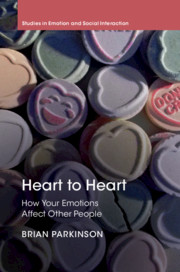Book contents
- Heart to Heart
- Studies in Emotion and Social Interaction
- Heart to Heart
- Copyright page
- Dedication
- Contents
- Figures
- Preface
- Acknowledgements
- Chapter 1 What’s at the Heart of Emotions?
- Chapter 2 Words and Concepts
- Chapter 3 Facial Activity and Emotion Expression
- Chapter 4 Explaining Emotional Influence
- Chapter 5 Regulating Emotions
- Chapter 6 Social Functions
- Chapter 7 Groups, Teams and Crowds
- Chapter 8 Working with Emotions
- Chapter 9 Reorientation
- References
- Index
- Studies in Emotion and Social Interaction
Chapter 1 - What’s at the Heart of Emotions?
Published online by Cambridge University Press: 28 October 2019
- Heart to Heart
- Studies in Emotion and Social Interaction
- Heart to Heart
- Copyright page
- Dedication
- Contents
- Figures
- Preface
- Acknowledgements
- Chapter 1 What’s at the Heart of Emotions?
- Chapter 2 Words and Concepts
- Chapter 3 Facial Activity and Emotion Expression
- Chapter 4 Explaining Emotional Influence
- Chapter 5 Regulating Emotions
- Chapter 6 Social Functions
- Chapter 7 Groups, Teams and Crowds
- Chapter 8 Working with Emotions
- Chapter 9 Reorientation
- References
- Index
- Studies in Emotion and Social Interaction
Summary
Are emotions simply private experiences concealed inside individual minds and bodies? Psychologists often search for their distinguishing characteristics in these internal locations. But focusing on physiological responses and cognitive appraisals distorts our understanding of emotion’s relations to the contexts in which it occurs. In fact, emotion is a form of relational activity. Unfolding transactions between people, objects, and events give structure to our emotional orientations to what is happening. And these orientations in turn influence other people and their own reciprocal orientations. Some social emotions, such as anger and embarrassment, directly target other people’s responses as ways of dealing with current concerns. Other emotions are oriented at non-social objects but still serve social functions by affecting other people’s orientations to those objects. Although emotions are often experienced privately, this is only possible because we have learnt how they work in more public arenas.
- Type
- Chapter
- Information
- Heart to HeartHow Your Emotions Affect Other People, pp. 1 - 26Publisher: Cambridge University PressPrint publication year: 2019

